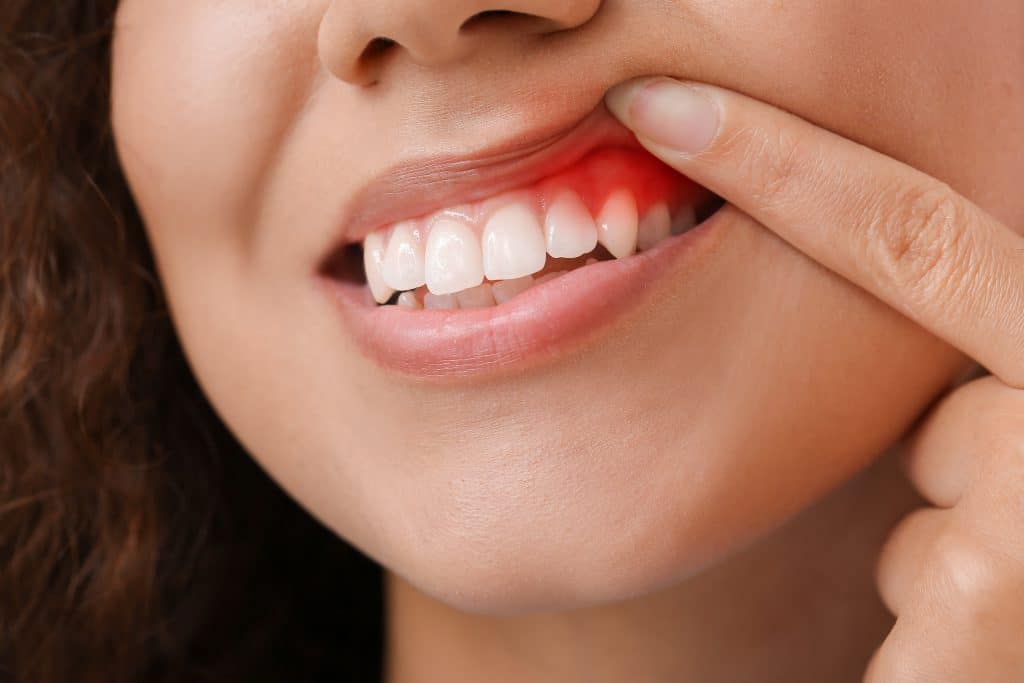A Comprehensive Guide to Achieving Optimal Oral Health

A Comprehensive Guide to Achieving Optimal Oral Health - Enzim Singapore
Bleeding gums, often an early sign of gum disease, can be distressing and may indicate deeper oral health issues. Gum disease begins with gingivitis, the mildest form of periodontal disease, characterised by gum inflammation. When neglected, gingivitis can progress to more serious conditions, leading to irreversible damage and even tooth loss. Understanding the causes, warning signs, and effective treatment methods for bleeding gums is key to preventing periodontal disease and maintaining a healthy mouth.
Understanding Gingivitis and Its Causes
Gingivitis, or gum inflammation, arises from bacterial plaque buildup on the teeth and gumline. Plaque—a sticky, colourless film of bacteria—hardens into tartar if not removed through regular brushing and flossing. This plaque and tartar provide an environment where bacteria can flourish, producing toxins that irritate the gums. When the immune system responds to combat this bacterial infection, the gums become inflamed, red, and swollen.
When plaque spreads below the gumline, it causes the gums to separate from the teeth, forming pockets that trap more bacteria. These pockets, if untreated, lead to the deterioration of the connective tissue and alveolar bone surrounding the teeth. Unlike other health conditions that produce immediate symptoms, gingivitis often progresses gradually, leading many people to overlook its seriousness until it advances.
The initial signs of gingivitis include red, swollen, and bleeding gums, particularly during brushing or flossing. Healthy gums should appear pale pink, not red or swollen. Chronic bad breath (halitosis) can also accompany gingivitis, as bacteria accumulated in plaque around the teeth emit foul odours. If untreated, gingivitis may advance to periodontitis, a severe gum disease that can cause irreversible gum recession and tooth loss.
Key Signs of Gum Disease
Knowing the early signs of gum disease can help you seek timely treatment and prevent it from progressing to more advanced stages. Look out for:
- Bleeding Gums: Often the first noticeable sign of gingivitis, bleeding gums occur when gums are irritated by plaque and tartar buildup.
- Red, Swollen Gums: Gums that are red, tender, or swollen indicate inflammation.
- Receding Gum Line: As the disease progresses, gums may begin to recede, exposing the roots of the teeth.
- Pockets Between Teeth and Gums: These pockets form when gum tissue pulls away from the teeth, creating a space that traps bacteria and food particles.
- Persistent Bad Breath: Known as halitosis, bad breath results from bacteria and plaque accumulating in the mouth.
- Loose or Shifting Teeth: As periodontitis damages the tissues that support teeth, they may begin to feel loose or change position.
Ignoring these symptoms can lead to a severe form of gum disease known as periodontitis. This stage involves the destruction of the bone that supports the teeth, making them prone to loosening and potentially requiring extraction.
Causes of Gingivitis and Periodontal Disease
Several factors contribute to the development of gingivitis, with inadequate oral hygiene being the primary cause. Additional factors include:
- Smoking: Tobacco use is a leading risk factor for gum disease and interferes with the normal function of gum tissue cells, making the mouth more vulnerable to infection.
- Hormonal Changes: Hormonal fluctuations during puberty, pregnancy, menstruation, and menopause can increase gum sensitivity, making gums more susceptible to gingivitis.
- Medical Conditions: Diseases such as diabetes and conditions that affect the immune system can make the body more prone to infections, including gum disease.
- Medications: Some medications can reduce saliva production, leading to dry mouth. Saliva is essential for protecting gums, and its reduction can make gums more vulnerable to infection.
- Poor Nutrition: A diet lacking essential nutrients, particularly vitamin C, can weaken gums and the supporting structures, making infection more likely.
Effective Treatment and Prevention of Bleeding Gums
Treating gingivitis early can prevent it from progressing to periodontitis. The primary goal of treatment is to control the infection, reduce inflammation, and prevent further damage. Treatment usually involves the following steps:
-
Professional Dental Cleaning: Your dentist or dental hygienist can remove plaque and tartar buildup above and below the gumline, where brushing and flossing alone cannot reach. This may involve scaling and root planning to remove plaque from the tooth roots and reduce inflammation.
-
Medication: In some cases, dentists may prescribe antimicrobial mouthwashes or topical antibiotics to control infection. Oral antibiotics may be necessary for advanced gum disease.
-
Surgical Intervention: If periodontitis is advanced, surgery may be required to remove infected tissue and reduce pockets. Options include flap surgery, soft tissue grafts, and bone grafting.
Preventing Bleeding Gums Through Daily Oral Care
Preventing gum disease requires consistent oral care habits, including brushing, flossing, and regular dental visits. Here’s a more comprehensive approach to maintaining gum health:
-
Brush Twice Daily: Use a soft-bristled toothbrush and brush for at least two minutes to remove plaque. Pay special attention to the gumline, where plaque tends to accumulate.
-
Floss Daily: Flossing helps remove plaque and food particles between the teeth that a toothbrush can’t reach. Use a gentle motion to avoid injuring the gums.
-
Use an Antibacterial Mouthwash: Antibacterial mouthwashes can help reduce plaque and gingivitis, but they should not replace brushing and flossing.
-
Regular Dental Check-ups: Regular visits to the dentist, ideally every six months, allow for early detection of any gum issues. Your dentist can also perform professional cleanings to remove tartar that regular brushing and flossing can’t remove.
-
Choose the Right Toothpaste: The right toothpaste can make a difference in gum health. Many toothpastes contain Sodium Lauryl Sulfate (SLS), an ingredient that can irritate sensitive gums. SLS-free toothpaste, like enzim 40 Plus, is a gentler option, particularly for those prone to gum inflammation.
Why Enzim 40 Plus Toothpaste is Ideal for Gum Health
Enzim 40 Plus Toothpaste contains a unique blend of enzymes and ingredients specifically formulated to support gum health. Unlike regular toothpaste, it’s free of SLS, making it ideal for sensitive gums. Key benefits include:
-
Enzyme-Rich Formula: The enzymes in Enzim 40 Plus work with natural proteins in saliva to balance bacterial growth in the mouth. These enzymes, including Amyloglucosidase and Glucose-oxidase, actively combat plaque-forming bacteria, reducing the risk of gum inflammation.
-
Colostrum for Moisturizing: Colostrum is a nutrient-rich substance that helps moisturise dry mouth, which can exacerbate gum issues. By keeping the mouth moist, it prevents the buildup of harmful bacteria.
-
Potassium Nitrate for Sensitivity Relief: Potassium nitrate helps alleviate tooth sensitivity, making it easier for those with sensitive gums to maintain their oral hygiene routine.
-
Silica Powder for Protection: Silica powder helps seal dentin tubules, protecting teeth from further sensitivity and providing a smoother surface that’s easier to clean.
-
Zinc Gluconate for Fresh Breath: Zinc gluconate reduces bad breath by inhibiting the growth of odour-causing bacteria, giving you the confidence of fresh breath.
-
Allantoin for Healing: Allantoin promotes the healing of minor cuts and abrasions, making it helpful for individuals with sensitive gums or minor gum injuries.
A Practical Approach to Using Enzyme-Based Toothpaste
For best results, use Enzim 40 Plus Toothpaste on a dry toothbrush. There’s no need to wet the brush before applying toothpaste, as the dry application enhances the effectiveness of the enzymes. Brush thoroughly for two minutes, ensuring you reach all areas, especially the gumline. This technique ensures that the enzymes make direct contact with the gums and teeth, maximising their benefits.
Lifestyle Tips for Gum Health
Beyond oral care, certain lifestyle habits can also support healthy gums:
- Balanced Diet: A diet rich in vitamins and minerals, particularly vitamin C, helps strengthen the immune system and keeps gums healthy. Avoid sugary foods and drinks that promote plaque buildup.
- Quit Smoking: Smoking is a significant risk factor for gum disease. Quitting smoking can vastly improve gum health and reduce the risk of serious oral health problems.
- Stay Hydrated: Drinking water helps wash away food particles and bacteria in the mouth, preventing plaque buildup.
The Long-Term Benefits of Preventing Gum Disease
Taking proactive steps to prevent gum disease can yield long-term health benefits. Healthy gums support a strong oral foundation, and by preventing gum disease, you can avoid painful and costly dental treatments down the road. Furthermore, research shows that gum health is linked to systemic health, with poor gum health being linked to conditions like heart disease and diabetes. By prioritising gum care, you’re investing in both your oral and overall well-being.
Final Thoughts
Bleeding gums may seem like a minor issue, but they’re often a warning sign of gum disease. By recognising the signs early and maintaining a thorough oral care routine, you can prevent gingivitis and protect your gums from more severe conditions like periodontitis. Enzim 40 Plus Toothpaste, with its enzyme-rich, SLS-free formula, is an ideal choice for maintaining bacterial balance, fresh breath, and optimal gum health. Prioritise your gum health now to enjoy a disease-free, confident smile for years to come.



